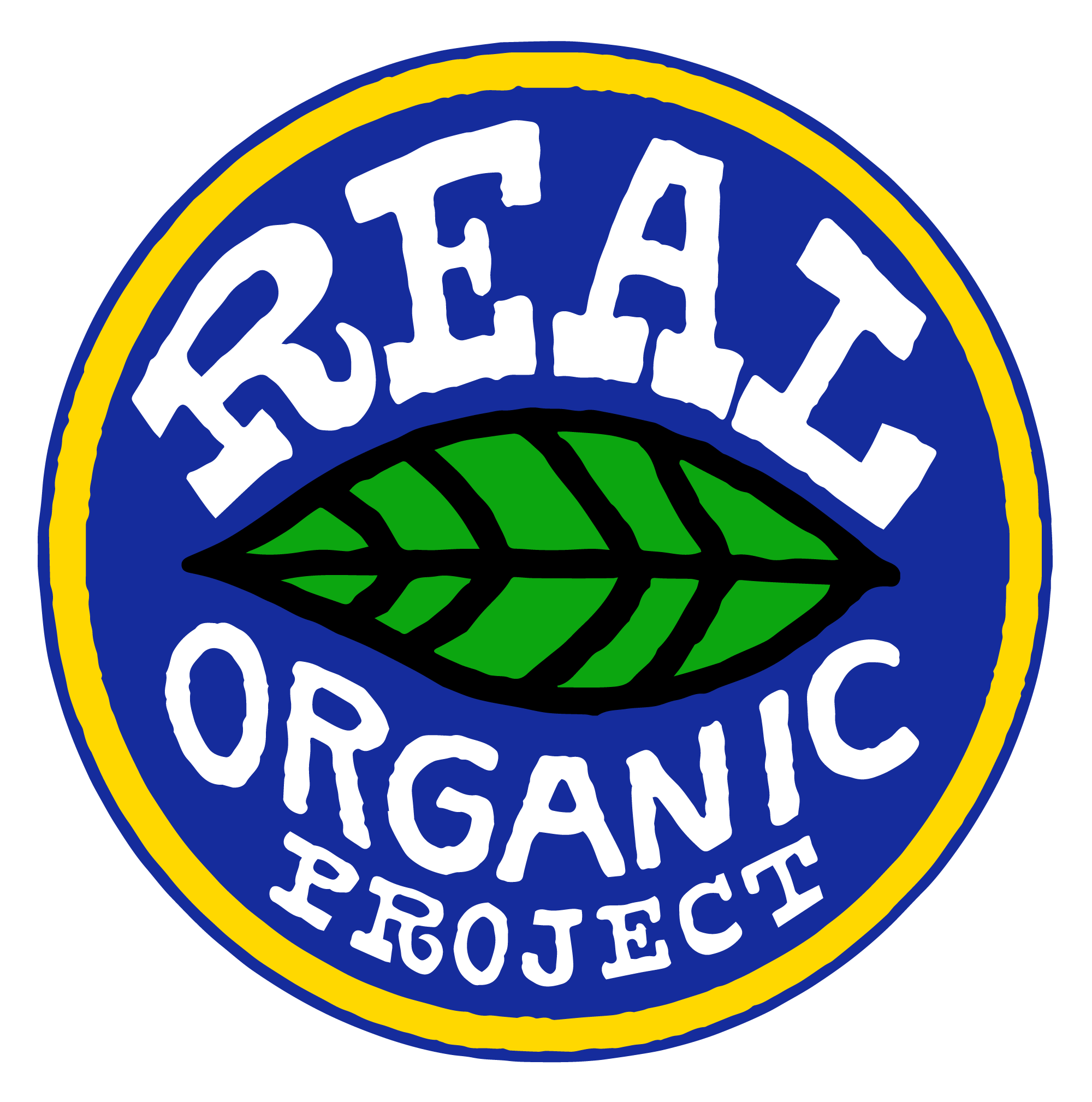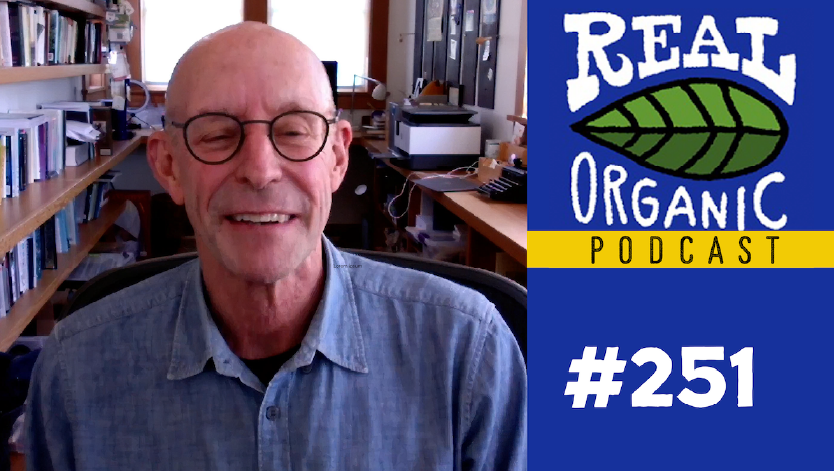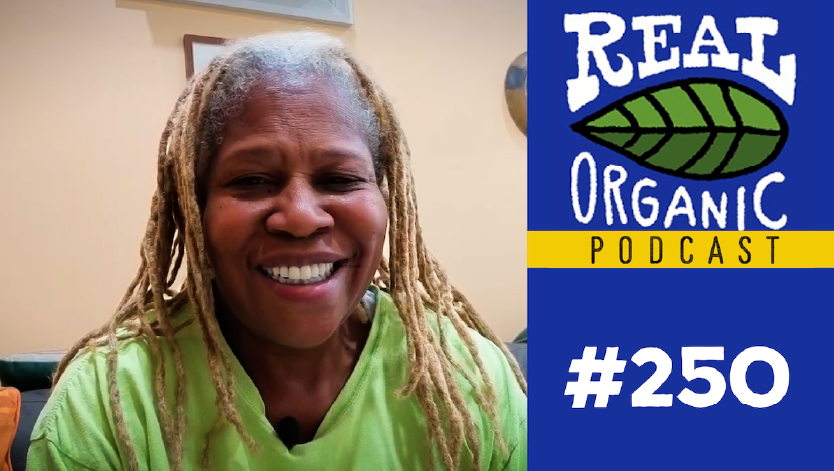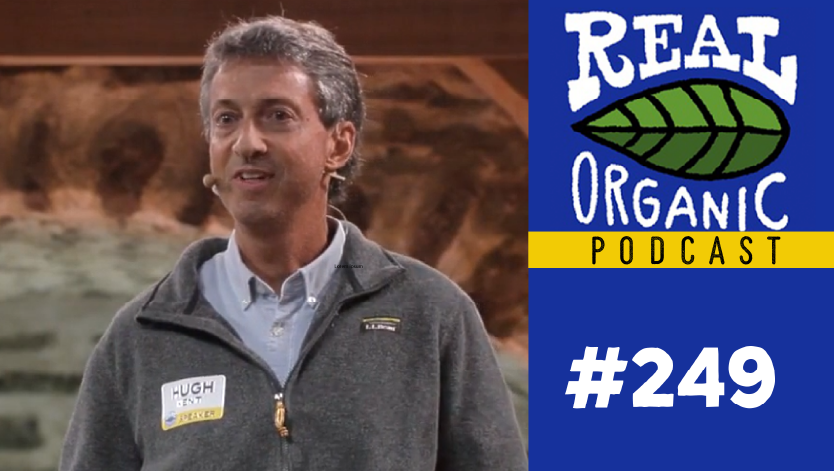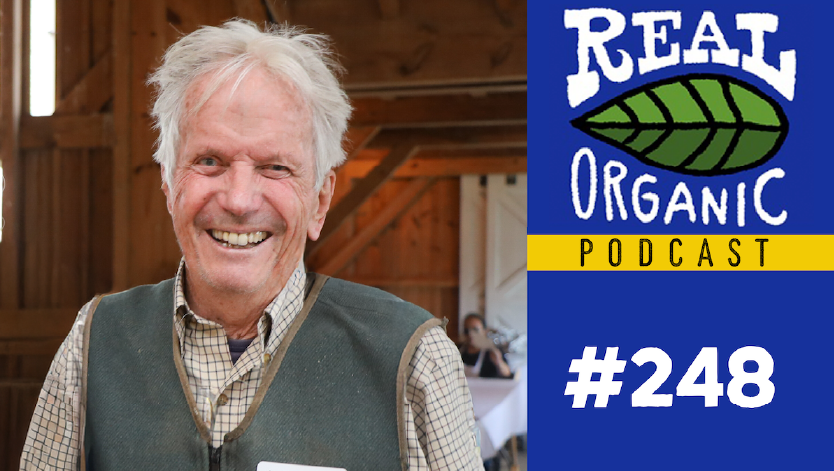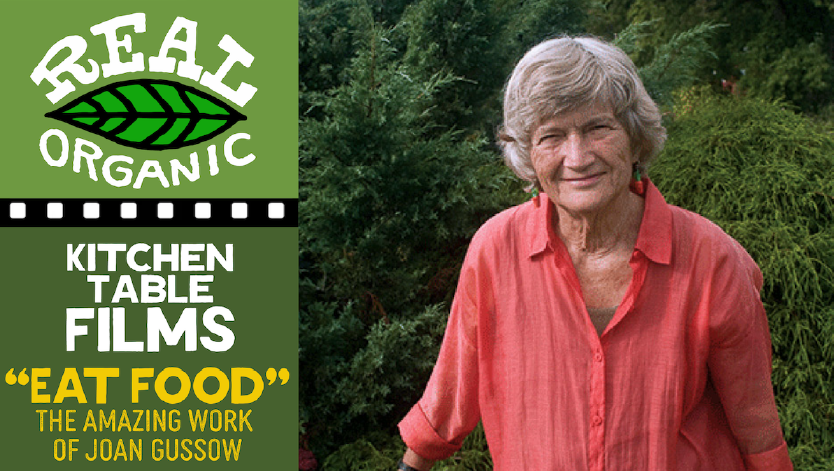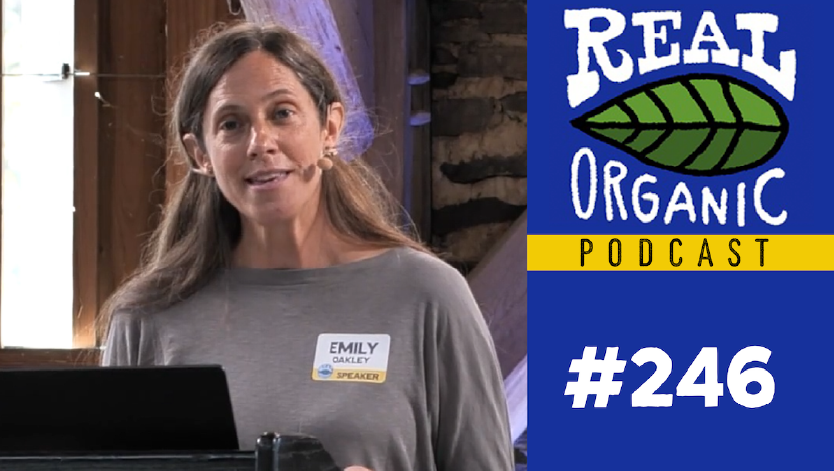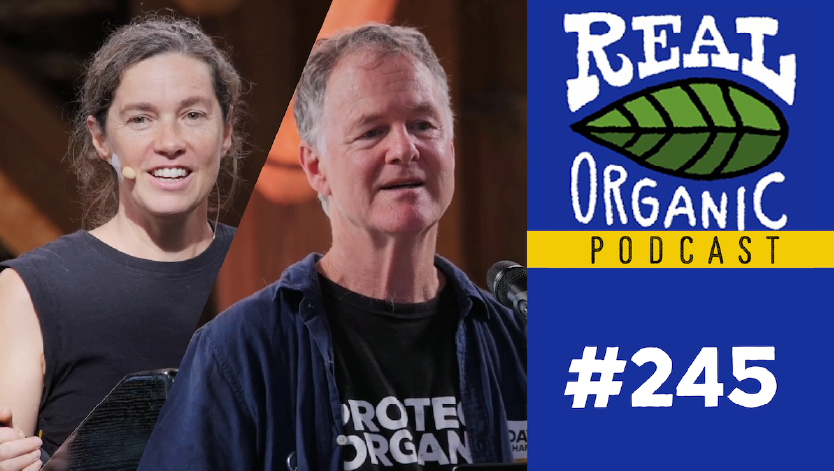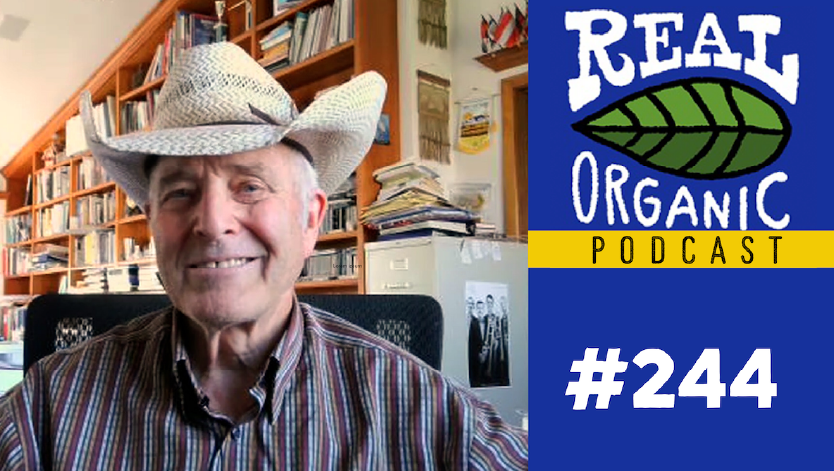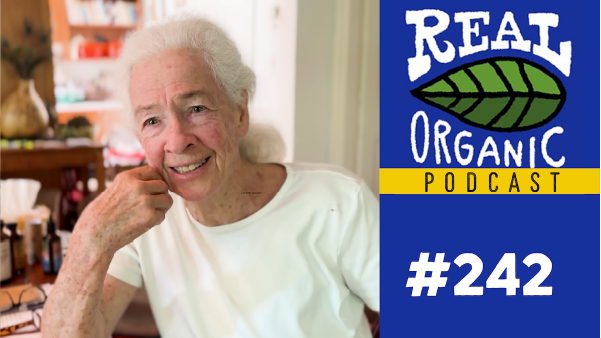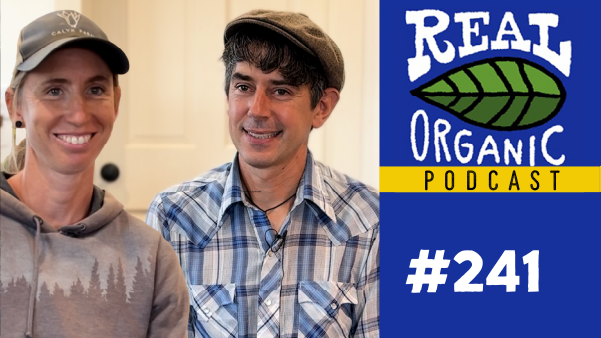Episode #243
Naomi Oreskes: The True Cost Of Doubt
Naomi Oreskes, renowned historian of science and author of Merchants of Doubt, brings her sharp insights into the fight for truth in our food system. With decades of research exposing how powerful interests manipulate public understanding of science, she connects the dots between climate denial, corporate influence, and the growing threats to organic farming. Her perspective sheds light on why defending soil health and protecting organic standards is inseparable from defending scientific integrity itself.
Our Naomi Oreskes interview has been edited and condensed for clarity:
You can subscribe and download episodes of our show through your favorite podcast app, our YouTube channel, or stream the audio-only version here:
Dave Chapman interviews Naomi Oreskes, September 2025:
Dave Chapman 0:00
Welcome to the Real Organic Podcast. I’m pleased today to be talking to Naomi Oreskes. Naomi, it’s been a long time. We were friends long ago, and you moved on here, there, and everywhere. Now you’re at Harvard. You’re a historian of science, and you wrote a number of books, but two that I’m very familiar with, one is “Merchants of Doubt: How a Handful of Scientists Obscured the Truth on Issues from Tobacco Smoke to Global Warming,” and the other is “The Big Myth: How American Business Taught Us to Loathe Government and Love the Free Market.” They have bigger titles. These are both very relevant to the work of the Real Organic Project. Thank you for taking the time. Thank you for writing the books. I’d like to unpack a little bit about “Merchants of Doubt: How a Handful of Scientists Obscured the Truth on Issues from Tobacco Smoke to Global Warming.” Could you talk a little bit about the themes? What drew you to that book, and what was your goal there?
Naomi Oreskes 1:05
As you said, I’m a historian of science, and one of the things I’m interested in is why people sometimes accept scientific information and sometimes they don’t. More than 20 years ago, I got interested in a group of scientists who were denying the reality of climate change. I thought that was pretty weird. They were fairly famous scientists. They were clearly highly intelligent people. One was a former president of the US National Academy of Sciences, so it clearly wasn’t a case of scientific illiteracy or lack of education. I got interested in why prominent scientists would deny the hard-won findings of their own colleagues. What I discovered, along with my colleague, Erik M. Conway, my co-author, was this astonishing and frankly depressing story about a kind of serial contrarianism. These people who denied climate change had also denied the scientific evidence of acid rain, the harms of DDT – pesticides – and the ozone hole. The real kicker was that this whole story began for them working with the tobacco industry, denying the scientific evidence of the harms of tobacco.
Dave Chapman 2:21
Same people?
Naomi Oreskes 2:22
Same people. Same people, same strategies, and so we thought, “Okay, something is going on here, and it’s not normal science.” As historians of science, we recognized that this was something different, and we wanted to know what it was.
Dave Chapman 2:38
What did you discover? It’s like a detective mystery, right?
Naomi Oreskes 2:43
I know. Some of my friends always said it should be the romance of whodunit. It’s a kind of why did they do it. What we found was a story about politics and political ideology, that these men – and they were all men – came out of the Cold War with a strongly anti-communist political orientation. They believed, rightly or wrongly – I would say wrongly – but they believed authentically, that government regulation of the marketplace was a slippery slope to socialism and communism, and that if you allowed the government to regulate dangers like smoking and pesticides, pretty soon the government would take over your whole life. It’s a kind of quasi-libertarian argument about just letting the free market sort things out. Because they felt this so strongly, they felt justified in making common cause with the tobacco industry, making common cause with the pesticide industry, and challenging the scientific evidence. My position has always been that we could disagree about what the solutions to these problems are, and I think people of good faith can. What they did that to me was a bad-faith move was not to say, “I’m against government regulation because I fear what it leads to.” What they did was to say, “I don’t believe the science.” By making that move, by attacking the science and denying the science, they opened up this world of hurt that we now live in, where people deny the science about all kinds of things, including organic food, the harms of pesticides, the safety of vaccines, and the contagiousness of COVID-19. There’s no end now to where we see this kind of mischief taking place.
Dave Chapman 4:23
We’ve stepped into “”The Big Myth: How American Business Taught Us to Loathe Government and Love the Free Market” already, which is great, but just to go back for a minute to “Merchants of Doubt: How a Handful of Scientists Obscured the Truth on Issues from Tobacco Smoke to Global Warming. Did you come up with that title?
Naomi Oreskes 4:39
It’s funny. I wish I could say that we did. It was an unnamed person in the marketing department at Bloomsbury Press. I’ve always felt guilty because sometimes people compliment me on what a great title it was. The only thing I can say is we had a bunch of working titles: “Fighting Facts,” “Challenging Facts,” and “Challenging Knowledge.” We had played around but never really settled on a title that seemed right. One day my editor called and said, “Well, someone in the marketing department suggested ‘Merchants of Doubt.’ What do you think about that?” To my credit, I did say, “Oh, my God, that’s perfect. That’s it.” Thank you, whoever that was – someone in the marketing department. But it comes out of a line in the book. There’s an infamous memo that’s been quoted a lot. A tobacco industry executive back in the 1960s said, “Doubt is our product, because it’s the best way of convincing people to ignore the science.” You don’t have to prove tobacco is safe, you just have to raise doubt about the science. If people aren’t sure, they’ll keep on smoking. This is a very famous memo, and in the book, we discuss it and we say, “So in effect, they were selling doubt.” That’s where the idea of “Merchants of Doubt” came from.
Dave Chapman 5:55
It’s a brilliant title because it’s so meaty. There’s a lot there. It’s interesting, I have thought about the things that we’re often dealing with, “merchants of confusion,” that they’re just saying, “Yeah, this is complicated, but what about this, and what about that?” But they’re very similar. I like “Merchants of Doubt.”
Naomi Oreskes 6:20
They are two sides of the same coin. Part of the whole point is you want people to doubt the science, and you want people to be confused. Because their own research – and the tobacco industry did market research on this – showed that if people were confused, confusion favors the status quo. If people are confused, they just say, “Oh, it’s too confusing. I don’t know what to do. I’m just going to keep eating my hamburgers,” or, “It’s too confusing. The science is unsettled. I’ll just keep smoking until the scientists sort it out.” These people know it’s really weaponizing confusion and weaponizing doubt to protect their interests, maintain the status quo, and keep people smoking, driving big cars, or whatever it is.
Naomi Oreskes 6:20
Were the tobacco companies actually confused themselves?
Naomi Oreskes 6:45
Absolutely not. The power of this whole story, and I think the power of the book, is that we show without any doubt whatsoever that they absolutely knew. The evidence for that is overwhelming, and in fact, it’s why the tobacco industry has now paid billions of dollars in fines and settlements, because they knew perfectly well. They knew since the 1950s that their product was deadly, they knew that it was addictive, and not only did they lie about the fact that it was deadly and addictive, they even worked to make it more addictive than it already was to keep smokers addicted to a deadly product.
Dave Chapman 7:41
What was the government’s role in all this?
Naomi Oreskes 7:50
It’s an interesting question. The government’s role has changed over time, but the key part of the government’s role in this, particularly if we look at the early story about tobacco, was that the government played a very important role initially in publicizing this information. When it became indisputable that smoking caused cancer and other deadly diseases, the US Surgeon General played a very important role in the famous Surgeon General’s Report that many of us have heard of, in which the Surgeon General used the authority of his office as the nation’s chief doctor to say, “Yes, this product will make you sick, yes, this product will kill you.” That was very important because the Surgeon General was viewed as independent, objective, and minding the health of the nation. There were a couple of Surgeon General’s Reports in the 1960s. Those really helped shift the public conversation, and they also empowered states and local governments that were beginning to pass restrictions on smoking, say in public places. It helped to empower the FAA to ban smoking on airplanes. Then, ultimately, it helped empower Congress to act on tobacco and to require warnings on cigarette packages. Now, could the government have done more? I have colleagues who think that tobacco should have been abolished, that it should have been banned, but the government did a lot, and it played an important role in helping educate people and helping implement tobacco control. Government also played a really important role in the legal domain. This comes a little later. The Surgeon General’s Reports in the mid-1960s took a little while, but then state attorneys filed lawsuits against the tobacco industry on the basis of exactly what we’ve just been discussing – that they knew that this product was deadly, they lied about it, they participated in false and deceptive advertising, and the states were left with billions of dollars in medical costs. So the state attorneys’ lawsuits against the tobacco industry were really a game changer in terms of identifying this industry as the bad actors that they were, and ending the doubt campaign – showing the American people that we had been lied to, that tobacco was killing us. If you go back to the 1950s, about 75% of all Americans smoked. Today it’s only about 25%. Millions of lives have been saved, and billions of dollars in health costs have been saved, because state attorneys, in their role as government officials, sued this industry for what it had done.
Dave Chapman 10:39
That would be government operating as we would hope government would operate to protect the citizens.
Naomi Oreskes 10:43
Correct. It’s one of the reasons this is such an important story, because our government does protect us, our government does what we need it to do. There’s also one more piece, which is the federal prosecution of the tobacco industry. In the 1990s, the federal government, the Department of Justice, led by a lawyer, Sharon Y. Eubanks, brought a lawsuit against the industry under the RICO statutes – the Racketeer Influenced and Corrupt Organizations Act. This was important because it exposed the tobacco industry as the corrupt organization that it was. The documentation that came out of that case played a very large role in our being able to write our book, because much of the proof about what happened came out of these lawsuits.
Dave Chapman 11:32
Being able to see behind the curtain is a huge part of all this.
Naomi Oreskes 11:35
Exactly.
Dave Chapman 11:42
Before we go to “The Big Myth,” I guess we better talk about climate change, because that was a big part of “Merchants of Doubt.” Tell us about the playbook there. How did the industry use doubt, sowing the seeds of doubt in order to postpone or completely avoid any kind of government regulation to change something that was a pretty big deal?
Naomi Oreskes 12:08
The playbook is exactly the same, and that’s really what led us to write a book about it. At the time, going back to the mid-2000s – this is 20 years ago – I was working on climate change, but mostly working on it as a historian of science. I was studying the history of climate science. I was trying to understand how scientists had sorted out what was going on, and when scientists had said, “Yes, the climate is really changing.” I published a paper in 2004, and this was at a time when many people were still claiming there was no scientific consensus on the issue. The President of the United States had said there was no consensus, and the Vice President of the United States had said there was no consensus. There were several times when I wanted to throw a shoe at the television. But instead of doing that, I did research to try to answer that question, “Well, is there a consensus? And if so, when did that consensus develop?” I published a paper in 2004 based on that research, in which I said, “Yes, there is a consensus, virtually unanimous among experts, and that consensus has been in place since about the early to mid-1990s.” I published that paper naively thinking that journalists and politicians were just confused, and that if I explained it clearly and patiently and in a non-condescending way, people would say, “Oh, good to know.” I was very naive, and when that paper was published, I started getting attacked. I got hate mail and threatening phone calls. People filed complaints with my university claiming that I must have been a fraudulent historian, because obviously people could see there was a big debate. So, if I couldn’t see that debate, then I must be an idiot. I was attacked and denounced on the floor of the US Congress by Senator James Inhofe of Oklahoma. That was what I call my Alice Through the Looking Glass moment, when my whole world turned upside down. I had been working under a premise that I thought many of us were raised with, especially those of us who went into science, which was that if you figure out the facts and you explain them clearly, and you publish them in reputable journals, people will accept those facts and they’ll act on them. That might have been true once upon a time, but it’s sure not true now. I started getting attacked, and it was the attack that led me to try to figure out what was actually going on, because this was clearly not a scientific debate. It was some kind of political or cultural debate. Then the piece of luck part of this story was that I met Eric Conway at a conference. Eric is also a historian of science. He was working on a book on the history of atmospheric science, and a big part of his book was this ozone story. The story of how scientists had realized that this particular group of chemicals, the so-called chlorofluorocarbons (CFCs), had the potential to destroy stratospheric ozone, which protects us from UV light, and without stratospheric ozone, we would be frying to a crisp at this very moment. Eric had been doing this work. He had come across a lot of information about attacks on those scientists, but he hadn’t done anything with it. He hadn’t published it, but when I started telling a group of colleagues about what was happening to me, he made the connection. He said, “Well, the people that are attacking you are the same people who attacked the scientists who worked on the ozone hole.”
Dave Chapman 15:42
The same people who are defending tobacco companies 20 years earlier.
Naomi Oreskes 15:48
The same people. We didn’t know that part yet. You didn’t know that yet? We didn’t know that yet. At this point, we just had two points on the line. We had climate and ozone. That seemed a little weird, but it didn’t seem catastrophically weird, because ozone is atmospheric chemistry, and climate is atmospheric physics. They’re related. It was plausible that the same scientists could be involved in both of those debates. It felt a little weird, but it didn’t seem totally crazy. Then Eric sent me a bunch of materials about this, and I recognized the names of some of the scientists involved, including someone who had been my own colleague at Dartmouth College, my very first job, Dr. Robert Jastrow.
Dave Chapman 16:43
You can ignore it because the mics are very good now, and they just pick up your voice and my voice.
Naomi Oreskes 16:48
Oh, that’s great. This group of scientists was very famous, and I recognized their names, including a man who had been my colleague at Dartmouth College, Dr. Robert Jastrow. Jastrow was an astronomer. He had written a number of popular books about astronomy, and he really didn’t know anything about climate change, so it seemed weird that he was involved in this debate. Then another one was a man by the name of Dr. Fred Seitz, a solid-state physicist who had been the president of the National Academy of Sciences in the 1960s, and that seemed pretty weird, too.
Dave Chapman 17:12
A towering figure.
Naomi Oreskes 17:18
A towering figure, right. A really big figure in American science. I just thought, “Why would someone like Fred Seitz question the scientific evidence of climate change or the evidence of the ozone hole?” I started digging, and that’s when I found the tobacco connection. It didn’t take very long to find out that Fred Seitz, and also a fourth fellow in this story, Dr. Fred Singer, had worked for the tobacco industry, and they had used the exact same arguments they were now using to question climate science as they had used to question tobacco science. That’s when I picked up the phone and called Eric, who I scarcely knew. I’d met him once at a conference. I said, “I think we should write about this together.”
Dave Chapman 18:04
That’s great. You said he sent you quite a stack of research he had already done.
Naomi Oreskes 18:10
Materials he’d collected. He hadn’t written anything about it because he was writing a book about the science, and this seemed to be the politics. He had done what I think a lot of us were taught to do, which was to think that the science and the politics were separate, and the realization we had was, “Oh, no, they really weren’t separate. This was a really interlocking story about scientific discovery triggering political opposition.” That was really the story that unified these different cases: ozone, climate, tobacco, and pesticides. In all these cases, the science was telling us these products are doing real harm, and the government should do something about it. But of course, the manufacturers didn’t want that to happen.
Dave Chapman 18:56
It’s really interesting to me, Naomi. Your understanding is that primarily they were motivated not by personal gain, but by politics, by their sense of democracy as a bulwark against communism, and that we needed to defend the American way by defending freedom of choice, in which government does nothing.
Naomi Oreskes 19:20
Exactly. I think it’s a little easier to make that argument today given what is going on in Washington, D.C., right now, but 20 years ago, when we first started making this argument, people were very skeptical. I think a lot of people just assumed that this was a story of money, as you said, that it was about personal gain. I think a lot of people found it hard to believe that people would go to such lengths to attack science over political ideology. Now I think we see it, because we see how divided this country has become over ideological questions, even to the point that many people are arguing positions that don’t actually seem to advance their economic interests. I feel like one of the important lessons of this story is you cannot reduce everything to money. Money is definitely part of this story, and there’s no question that money was the driver for the companies themselves. The tobacco industry, I don’t think it gave a hoot about democracy. It cared about profits, but it made common cause with people who do have these strongly held political views. It’s that common cause that I think made this so powerful and so toxic. Because now you have the power and the money of the tobacco industry linked to an ideological argument that seems to be in some ways virtuous. Because who among us doesn’t believe in freedom, and who among us wouldn’t say that, ceteris paribus, we ought to be able to decide for ourselves how to live our lives. In fact, something I’ve often said in public that sometimes upsets my public health friends, I feel like in a perfect world if using tobacco didn’t hurt other people, then as far as I’m concerned, if someone wants to smoke, and if they know, if they have the truth about the risks, then it’s really not for me to tell them whether they should smoke or not. But the problem with that set of ifs is, A, they didn’t have the truth because the industry lied to us about it, and B, when you smoke, it does hurt other people, because one of the things we learned, and one of the things that the industry fought the hardest to deny, was that when I smoke, it puts you at risk as well. When I smoke, it puts my children, my partner, my bartender, and my flight attendant at risk. To me, this is the core failure, the Achilles heel of all libertarian and libertarian-leaning philosophies. It’s fine to say we should all get to decide for ourselves how to live our lives. Sure, that’s a great idea in principle, but the reality is, we’re all interconnected. When I smoke, it does affect people. When I drive a car or fly on an airplane, those greenhouse gas emissions go into the atmosphere and affect us all. When I use pesticides, I could say, “Oh, I don’t mind if my green peppers have pesticide residues. That’s a risk I’m willing to take.” Well, okay, but those pesticide residues end up in a river that goes downstream. It affects plants, birds, and all the people who live downstream. It goes all the way to the Gulf of Mexico and affects the aquatic ecosystems. Everything we do is interconnected. That’s the whole lesson of ecology. The idea that I can just decide for myself, that’s an idea that really doesn’t hold up to scientific scrutiny, and that’s why I think the right wing in this country, the libertarians, have so turned against science, because science proves that their idea may sound good in principle, but it never works in practice.
Dave Chapman 22:48
That’s really good. That’s very clear. I’m almost ready for “The Big Myth,” but there’s one more. It’s okay. Do you know who E. Bruce Harrison is?
Naomi Oreskes 23:03
Sounds familiar, but…
Dave Chapman 23:04
The father of green washing, he’s been called.
Naomi Oreskes 23:06
Oh, okay. Yes, I have heard of him.
Dave Chapman 23:08
He was a real glad-hander and a charming person. As a young man, he was involved in the campaign to demonize Rachel Carson.
Naomi Oreskes 23:24
That’s where I’ve come across it.
Dave Chapman 23:25
They took on Rachel Carson and Ralph Nader. They destroyed Ralph Nader, but they failed with Rachel Carson. They tried to destroy her. They said, “She never finished her Ph.D., she’s not really a scientist, and we’re pretty sure she’s a lesbian, and all these other things. We shouldn’t listen to her.” It didn’t work.
Naomi Oreskes 23:44
Yes. I think the main reason it didn’t work is because, frankly, she died. She died rather soon, only a few years after writing “Silent Spring.” Although it’s not impossible to demonize a dead person – and indeed, in the 1990s there was a second wave of anti–Rachel Carson activity that we actually write about in “Merchants of Doubt: How a Handful of Scientists Obscured the Truth on Issues from Tobacco Smoke to Climate Change,” where they did, posthumously, demonize her – I think the fact that she died, and she died of breast cancer, and of course, there was already evidence at that time that DDT caused cancer, made it a little bit harder for her enemies. But also, the other important part of the story again gets back to the government. One of the crucial reasons why Rachel Carson’s work had the impact it did was that she was a beautiful writer. “Silent Spring” is an amazingly, beautifully written book. Even though it delivers a negative message, it is written in a very beautiful and positive way, and I think that was super important. It’s a beautiful book to read. People wanted to read it, and people enjoyed reading it, even though it’s a sad story. But also, she was defended by the federal government. John F. Kennedy, President Kennedy at the time, asked his President’s Science Advisory Committee to review the scientific evidence and to give an objective appraisal of whether or not her reading of the science was correct. They said, “Yes, absolutely.” That was made rather public in the mid-1960s, and it was part of what led to the creation of the Environmental Protection Agency. One of the very first actions that EPA took in the early 1970s was to ban the use of DDT in the United States. It wasn’t just that Carson did this very important piece of work and writing, but she was defended by the president of the United States and his top scientific advisors. That’s similar to the Surgeon General story – having the argument validated by a high-level government official, an official who represents the interests of the American people, is a very powerful combination. Carson had that in a way that many of us don’t have today.
Dave Chapman 25:54
Yeah, that’s right. The next step of that is that Harrison came up with a different strategy for climate change. It actually wasn’t one of doubt. It was saying, “They’re right.” He was representing the oil companies, and he said, “You need to go to Rio in 1992, and you need to say the truth, which is that climate change is real, it’s caused by the burning of fossil fuels, and voluntarily say, ‘We’re going to fix this.'” It was interesting because they weren’t saying, “Well, we’re not quite sure about this.” They said, “We’ve got to cut it off at the pass.” Are you aware? Have you thought about that strategy that they used? I’ve heard it said that it set back the climate movement by a generation.
Naomi Oreskes 26:49
I think lots of things set back the climate movement, because one of the things we’ve shown in our work is that the industry is very clever, and they work on multiple fronts. Often they will try as many different things as they can, and they’ll see what works. Sometimes they’ll do one thing for a little while until it stops working, and then they’ll do something else. We’ve seen the fossil fuel industry pursue all these different strategies. There have been times when they absolutely denied that climate change was happening. There have been times when they said it was real, but it wasn’t caused by their products – it was just natural variability. There have been times when they said, “Well, it is real, and it is caused by fossil fuels and deforestation, but it would be too expensive to fix.” We’ve seen all these different strategies, and one of the strategies is greenwashing. As you said, greenwashing begins early in this campaign. We see it from very early periods: “We’re going to make a good faith effort, we’re going to be partners, we’re going to work together with government and the public to fix this.” But while they’re saying that, it’s the old magician’s trick. They’re over here: this is the ribbon, this is the hoop. “We’re great. We’re committed to fixing this.” But over here, they’re funding climate denial organizations. They’re funding lobbying to prevent action. What we know about that early period around the Earth Summit at Rio in 1992 is that many of the corporations did say they were committed to being good partners, but they began to fund a group called the Global Climate Coalition, whose express purpose was to stop the United States from ratifying the Kyoto Protocol. The Kyoto Protocol was the protocol to the UN Framework Convention on Climate Change, which was going to create binding emissions limits. The UN Framework Convention on Climate Change, passed in 1992, is a statement of principle, but there’s no enforcement mechanism, no emissions limits. The Kyoto Protocol was the piece that was going to say, “Okay, and now that we’ve agreed to that, here are the binding limits.” The Global Climate Coalition, funded by the fossil fuel industry, stopped that from happening.
Dave Chapman 28:57
Which is example Bill McKibben, when I interviewed him, said, “I thought we were having a debate, and it turned out that we were just having a fight.”
Naomi Oreskes 29:10
Yeah. Lots of scientists have said that too. Lots of scientists I spoke to in that early period, when some of the fossil fuel companies were saying, “We don’t really know. We think we need to do more research,” thought they were having a scientific debate. They thought if they just did more research, if they answered some of these key questions – and often the questions weren’t illegitimate, “How do we know it’s not cloud feedback? How do we know it’s not this or that?” – then it would all be settled. But what they found instead was that for every question they answered, the fossil fuel companies would come up with another, and another, and another. One admiral I know said it’s kind of like a game of fetch. The climate deniers would throw a bone and say, “Fetch,” and then the scientists would scramble, running after the bone. They would get it, and they’d trot back, saying, “Okay, here it is. We got the answer.” Then the industry would say, “Oh, but what about volcanoes? Fetch.” Then the scientists would go running off again. We’ve seen that over and over again with various different claims: about cloud feedbacks, about volcanoes, about the claim that global warming stopped—which was never true. But scientists, sadly, often fall for it, because scientists want to do science. Scientists want to believe that people are negotiating in good faith, and scientists want to answer questions. I like to answer questions. Early on, there was a period when I had my whole notes prepared with, “How do we know it’s not volcanoes?” All these things – I was always ready to answer. It’s not that we shouldn’t answer those questions. Of course, we should. Sometimes you could meet a person in Nebraska, in North Carolina, in California, wherever. For that person, it might be a good faith question, because maybe they heard it somewhere, and now they’re thinking, “Oh yeah, how do we know?” But they didn’t get it from a good faith source. They got it from a climate denial website, or they got it from ExxonMobil. Now you’re in this tricky situation where you really do need to answer the good faith questions that people are posing, but the reason it’s in circulation in the first place is not because of a good faith conversation. It’s because of disinformation promoted by the fossil fuel industry.
Dave Chapman 31:23
We could define disinformation as putting out information that they know is wrong.
Naomi Oreskes 31:29
Correct. My mnemonic on that is, disinformation is deceitful. It’s dishonest. All those good D words. As opposed to misinformation, which could just be a mistake. Often people are confused, and that’s understandable, because it’s a confusing issue. In my own work, I always really try to be super sympathetic to people who are confused. It’s not our fault we’re confused. People have been trying to confuse us. But when it comes to people who are deliberately promoting disinformation that they know is wrong, then I have a lot less empathy for that.
Dave Chapman 32:05
Yeah, absolutely. All right. I think it’s time for your last book, The Big Myth: How American Business Taught Us to Loathe Government and Love the Free Market. It’s a natural continuation of the conversation, but I think it’s going very deep into what’s really going on here. What is the Big Myth?
Naomi Oreskes 32:32
The Big Myth is what Ronald Reagan used to like to call “the magic of the marketplace.” The idea is that markets have wisdom, that markets are intelligent, that the market is guided by an invisible hand, and it all works out. So all we have to do is step back, not interfere, and particularly make sure the government doesn’t interfere, and we’ll get optimal outcomes for all the things that we’re concerned about. That’s the Big Myth. The myth that we can just trust the free market to do the job we need it to do, and that we don’t need government action in the marketplace.
Naomi Oreskes 32:55
What’s wrong with that?
Naomi Oreskes 32:57
It’s not true. We have 2,000 years of history to show us that it’s not true, and it’s not true on multiple levels. In the most basic, historical, rudimentary sense, we have had markets for as long as we know. Historical records show there were markets in ancient Rome, ancient Greece, and Pompeii. One of my favorite things I saw in Pompeii was a shop where you could see the wood had been carved out, where people had collected their coins. People have been doing business – buying and selling stuff – since time immemorial. And guess what? They have had rules about how markets should operate since time immemorial. Because the reality is, there’s no such thing as the free market. Markets are people exchanging stuff, buying and selling in the marketplace. Sometimes people lie, sometimes people cheat, and sometimes people accidentally put stones in the bag of potatoes. You can find rules for how markets should operate in the Old Testament, in Leviticus. The basic idea that markets could operate without rules has no historical foundation. So it’s historically false. But it’s also untrue if we look at the history of capitalism. If we fast forward to the period we would identify as capitalist—say, since the late 18th century – even in just that time we see what economists call market failure. Markets, left to their own devices, don’t always give us good results. One of the most articulate people on this issue is Adam Smith. My favorite part of the book is actually our discussion of Adam Smith, because a lot of people think that Adam Smith was this advocate of absolutely unregulated, untrammeled free markets. The right wing in this country – the libertarians, and The Wall Street Journal – promote this idea that that’s what Adam Smith believed. But it’s not true. If you actually read The Wealth of Nations, you see that Adam Smith says, “Well, actually, banks need to be regulated. You cannot trust the self-interest of bankers, because bankers will lend all this money, they’ll offer cheap credit, and guess what? The whole economy could collapse.” That was a cool thing to read after the 2008 housing collapse in the United States, and I was rereading it right around the time of the collapse of the Silicon Valley Bank. Adam Smith recognized in 1776 – so more than 250 years ago – that you have to regulate banks. He gives the analogy of firewalls. He says, “Look, we have firewalls. We don’t just let people build any old building, because we know if a fire breaks out in one house, it will quickly spread to the house next door.” In fact, this is what had happened in the Great Fire of London. You have to have regulations to make sure that you build firewalls between buildings. He says, “The regulations of banking that I’m proposing – me, Adam Smith – are exactly the same as firewalls.”
Dave Chapman 36:11
Okay. He also had a lot to say about monopoly.
Naomi Oreskes 36:17
Exactly, right.
Dave Chapman 36:18
Could you talk about that. I actually love this conversation.
Naomi Oreskes 36:22
Thank you. I know. Me too. One of the paradoxes of capitalism is that capitalism is based on the idea of competition. The marketplace works well when we have competition, because if you sell crappy bread, then I’m not going to buy your crappy bread if there’s another baker down the road who has better bread, or maybe the same bread but at a better price. The whole notion of supply and demand, of markets responding to people’s needs, depends on competition. If you’re the only banker in town, or you’re the only baker in town, then I’m kind of stuck, and you can sell me a product that’s as bad as you like, and I’m stuck because I don’t have anywhere else to go. One of the problems with modern capitalism is that very often it becomes monopolistic, and by the end of the 19th century this had become clear as a very major problem, particularly here in the United States, with the rise of railroad monopolies, electricity monopolies, and steel monopolies. In the United States, we passed laws to prevent monopolistic practices. The most important was the Sherman Antitrust Act, followed a little bit later by the Clayton Antitrust Act, because people saw with their own eyes that you couldn’t just let the free market operate. The free market pretty soon became very unfree because of the risk of monopolies. We’ve known since the 18th century that we needed banking regulation. We’ve known since the 19th century that we needed regulations to prevent monopolistic practices. In the 20th century, a whole set of other things became clear, and this is what the new book begins with. It begins with child labor. Because the other thing that happens is, if you let business people – and in those days, it was almost all businessmen, so we’ll say businessmen, but it could be business people – if you let them just operate however they want to, they will cut corners. They will do whatever they can to reduce prices and increase profits. That’s been shown time and time again. In the early 20th century, both in the United States and in Europe, child labor was very widespread. Here in Massachusetts, there were children as young as two years old working in textile mills, and half of them died before the age of 21. A movement began to develop, both in Europe and in the United States, but our book focuses mostly on the US, because that’s where we are, to ban child labor. The business community began to fight back. What we show in the new book is that we see the beginnings of this argument about freedom and free markets not in the 1950s with debates over tobacco, but actually in the 1900s, in the early 20th century, over child labor and also workman’s compensation. Children were dying in factories. Children were dying in mines. Children were dying in textile mills. And all across the country, workers were dying on the railroads, in mines, and in mills. In those days, if a worker died – if a worker was killed – that person’s family was left with nothing. Many women and children were destitute after the death of the male breadwinner. Railroads were particularly dangerous. So a movement developed to try to ban or limit child labor, and a movement developed to create a workman’s compensation scheme. These movements were successful. Many states began to pass laws, and the federal government passed a workman’s compensation system, which today we totally take for granted. But the business community began to fight back. How did they fight back? Did they say, “Oh, we think it’s good that we kill our workers?” No, of course they didn’t say that. Did they say, “Yeah, we think it’s right that two-year-old children are being trapped in looms in Lowell, Massachusetts?” No, they didn’t say that either. They said, “It’s about freedom. We should have the right to decide how to run our own businesses. The government doesn’t know how to run my business.” The other piece of the story was an argument about government inefficiency. How could the government possibly think that they knew better than me how to run my own business? They began to develop this argument about efficiency and about freedom, and to say that the government should not intervene in the marketplace, because that threatens, initially, economic freedom. But then they began to argue that once you give up economic freedom, it’s only a matter of time before you begin to lose your other freedoms as well. We argue in the new book that this is where this political argument about defending the free market and opposing regulation really finds its original roots.
Dave Chapman 41:06
That’s a very compelling claim – that the only way we can maintain our personal freedom and our democracy is through an unregulated marketplace.
Naomi Oreskes 41:19
Exactly.
Dave Chapman 41:21
You talked about about workers compensation, but there’s also OSHA…
Naomi Oreskes 41:27
That comes later.
Dave Chapman 41:28
…and protecting workers’ safety, so that you don’t end up with a widow who doesn’t know what to do. That really comes in during the 1930s.
Naomi Oreskes 41:41
What happens is, this is a long story. It plays out over a long period of time. It’s not really until the Great Depression that things really begin to change in a big way. A number of states passed child labor laws, but the Great Depression really changes the whole conversation. Part of the argument that business leaders in this country made was that, “America is a very prosperous country. Look at all these things that Americans have. We’re the envy of the world. We have more electricity. We have more stuff. Ford is making Model T Fords.” This prosperity comes from freedom, and it comes from the free market. Up until 1929, that argument seems kind of plausible to a lot of people. Then you get the crash in the Great Depression, and all of a sudden, that argument doesn’t seem so plausible. Suddenly, the business community that had been telling us that they were delivering all this prosperity, and that the price of that prosperity might be a few workers killed here and there—although it’s a whole lot more than a few – suddenly that whole argument really doesn’t seem to hold water. The American people become much more sympathetic to the idea that the federal government needs to play a big role in the economy. FDR is elected in 1932 and immediately begins to make a lot of changes – more regulation of banks, regulation of securities to prevent securities fraud, which had played a pretty big role in the crash. Finally, in 1938, after decades of arguing, we get a law to limit most forms of child labor. Workman’s compensation had already been put in place, but other protections for workers, minimum wage, and a limited 40-hour workweek were added – a whole set of policies that really change America in a big way and make America a much safer place for workers, a much safer place for children, and also introduce Social Security. Part of the reason workman’s compensation had been such a big issue was that if a factory worker was killed, his family was left with nothing. Because there was no workman’s compensation, there was also no Social Security. Social Security ensures that families are not left destitute. I would say, and in the book we argue, that from about 1932 until about 1980, there’s a broad consensus in American culture that government does have to play a significant role in the economy, that governments do have to protect workers and children. But then it begins to change with these environmental questions. We can get into that more, but the short answer to why it changes is that the business community has been a little divided on this issue. During the Great Depression and the New Deal, there were portions of the business community that agreed that things had to change, and there were certainly portions that supported banking regulation and limits on child labor. But there were others who didn’t and who continued to push back against it. In the book, we follow those who continue to push back. One of the things those folks did was cultivate and develop Ronald Reagan. Reagan, in the late 1970s, becomes the standard-bearer of the argument that government intervention in the marketplace is a bad thing. Up until then, that argument had not really gained traction. But in the 1970s, the American economy starts to sputter. We have the Arab oil embargo. The price of oil skyrockets. Some people may remember waiting in line to buy gas. We have stagflation – the economy is stagnant, but inflation is still high. This combination of economic problems creates an opening for Reagan to say, “Well, we know what the cause of that is. The reason the economy is stagnating is overregulation, and what we need to do is dial back government regulation.”
Naomi Oreskes 45:32
Actually, that’s where we are now.
Naomi Oreskes 45:49
That’s where we are today, 40 years later. A big part of this argument has to do with the environment. By the 1960s and 70s, most people, including most conservatives, had accepted that child labor was not a good thing. Most people had accepted that workman’s compensation makes sense and is fair. But what they didn’t like was the rise of environmental protection. This is the other big piece about capitalism that we have to talk about. We’ve already discussed market failure in terms of bank regulation, but the other really big piece where capitalism fails us is what economists call external costs. The textbook example of an external cost is pollution. Imagine I have a shoe factory. I’m manufacturing shoes, and my shoes are good shoes, and I sell them at a fair price, and you buy them because they’re good shoes. But what you don’t know is that when I’m making those shoes, or maybe tanning that leather, I’m using toxic chemicals that I’m dumping in the river behind my factory, and those toxic chemicals are killing fish, killing birds, maybe poisoning people who are using the water downstream, maybe taking a river that used to be good to swim in, but now we can’t swim in it. These are all real costs that are not reflected in the price of the object in the marketplace. That’s a market failure. This has been known for a long time. It was first discussed by an economist named Arthur Pigou in the early 20th century. Pigou said there is a solution. The solution is a tax. We put a tax on the object to cover those external costs, and then we can use the money to clean up the river, and also the tax is a disincentive for the person to do the pollution. Pigou proposed a solution to this problem 100 years ago. He wrote about this in the 1920s, and sometimes these are called Pigouvian taxes. Many people, including conservative economists, have suggested that a solution to climate change is a carbon tax. It’s not a radical idea; it’s not even a left-wing idea. But the fossil fuel industry doesn’t want that, because if carbon costs more than oil, gas, and coal, then people are incentivized to find and use a different product. That’s the whole point. You want people to be incentivized to move away from the damaging product and toward something less damaging, but if you’re the manufacturer of that damaging product, you don’t want that. The fossil fuel industry, and not just the fossil fuel industry but also the pesticide industry and the chemical industry more broadly, begins to push back against environmental regulation. In the late 60s and early 70s, a whole group of statutes were passed: the Clean Air Act, Clean Water Act, National Environmental Policy Act, and a bunch of other laws. These really created the framework of environmental protection in the United States post-1970. This is what Reagan begins to push back against. George H. W. Bush was somewhat okay, but certainly in the George W. Bush administration, we see a wholesale attack – not just on the statutes and regulations, but even on the EPA itself – in an attempt essentially to dismantle the agency from within, with the firing of thousands of scientists and the appointment of someone in charge of the EPA who doesn’t believe in the mission of the agency.
Dave Chapman 49:27
Thank you. I know it’s hard. We know that. Here we have a difficult subject, which is that as we have this public conversation, we may encounter disinformation- people saying things that they know aren’t true in order to advance their agenda. What I see is that the people who want deregulation have a great deal of money. It’s very profitable, and they want it to be even more profitable. People who want regulation don’t have a great deal of money. Yes, that’s true. We see that money is incredibly influential in who is in government, what party is on top, and which politicians are on top. We see it manifest in all kinds of ways. It’s used to pay for journalism. It’s used to pay for academia. It’s used in all kinds of ways, including social media. Social media. All kinds of ways of influencing us that are almost invisible. When people talk about, “I don’t want the nanny state. I don’t want the government telling me what I can eat,” I go, “Don’t you know that somebody is telling you what to eat, and they’re actually doing a pretty good job of it?” They’re doing such a good job that you’re not even aware of it, and they’re telling you, and they’re successful. You’re eating this crap because they told you this would be a good idea. I know you’re aware of this, and I think we probably have to move toward closure here. I know we talked about this earlier: everybody always asks you, “What can I do?” You gave a beautiful answer, and it’s not just personal. It’s also, what can my group do? What can we as a people do? And some of it is, what can I as a person do? How do we stand up? We talked about David and Goliath. It can be David and Goliath, but what do we do when we have just a little slingshot and a stone and we’re up against a behemoth?
Naomi Oreskes 51:47
It’s a really tough question, and I don’t want to be one of those facile people who says, “Oh, don’t worry, it’ll all be fine,” because I don’t think it will all be fine. I think we need to be motivated to action, in part because unless we are motivated, it won’t be fine. I think every one of us has to get involved. I think sometimes people say, “Oh, I don’t like politics. It’s messy. It’s ugly.” That’s true – it is messy and ugly. But if we don’t all get involved, then the big money forces win, because they have all the money, but there are more of us. It’s not just David and Goliath; it’s also one Goliath and 330 million Davids. I think that’s really important to remember: there are always more of us than there are of them. That’s why any answer has to be a both-and. I often get asked, “What can I personally do as an individual?” One of the things I like to do there is quote Bill McKibben, who says, “Don’t try to solve these problems as an individual.” These are structural problems, and we can’t solve them on our own. I often say I can change my light bulbs, but I can’t change my electricity grid. We have to organize. We have to find common cause with people who share our values and concerns. Maybe it’s organic food, maybe it’s protecting winter sports against climate change, which is something I’ve been involved in. Maybe it’s local democracy, maybe it’s voting rights broadly, maybe it’s tax reform. Find the angle that motivates you to get involved and then get involved. Especially, I think the tax reform issue is really important because it’s a reminder that no matter what gets your blood boiling, it is relevant. You were just talking a moment ago about big money and its influence in politics. A lot of that has to do with our tax structure. When Dwight Eisenhower was president, the top marginal tax rate was 92%. Imagine even having that conversation today, even with liberal Democrats. Now, it’s what? 35, 40 something like that. Part of the reason money has so much power in this country is that we have allowed individuals to amass colossal, breathtaking, astonishing fortunes – 360 billion dollars. What even is that? You can’t even wrap your head around it. Even a person who had $30 million would be a colossally rich person. Now we have people who have hundreds of billions of dollars. They can buy whole social media outlets. They can buy senators. They can change the outcomes of elections because they have so much money. One thing we desperately need to do in this country is work for reform of the tax system and roll it back to something more like it was before, because so much of the income inequality in this country – which translates to political inequality – is due to our tax system. It doesn’t have to be that way. It wasn’t that way before. It was different in the past; it could be different again in the future. We have to think about those structural aspects, but at the same time, that’s a long game. I feel like one of the lessons of our work is that we look at the amount of time these business leaders worked to develop their arguments, to cultivate the University of Chicago, to cultivate Ronald Reagan, to get him elected. It was decades of work. They were patient, and they didn’t give up. It means we have to be patient too, and that’s hard. We also have to think about what we can do in the short run, and that’s where the individual piece comes in. I think it is important for individuals, for all of us, to think, “Well, what can I do in my own life so I don’t feel depressed, or so I feel like I’m at least taking arms against the sea of troubles?” Then food becomes really, really important, because food is an area where we have a lot of agency. Most of us are able to make choices about our food – not everyone, some people have more choices available than others – and grocery stores and supermarkets do respond to consumer demand. I worked with Robbie Kenner when we made the film version of Merchants of Doubt. His previous film was Food, Inc., which was a very influential food film. It did very well commercially. Studies afterward showed that it affected people’s thinking about food. There’s a great scene in that film where people from Walmart are discussing the decision to sell organic yogurt at Walmart. I can’t remember if this is in the film or if Robbie told me afterward, but the guys said, “Yeah, we didn’t give a shit about organic food, but our customers wanted it.” So, consumer demand can make a difference. It makes a difference to your own health when you eat better food. You’re doing something positive for the planet, but also positive for yourself, and that’s an area where you have agency. I focus mostly on climate change. The carbon footprint of beef is 60 times the carbon footprint of lettuce. Obviously, we’re not going to live only on lettuce, but it’s about 30 times the carbon footprint of eggs. We have lots of good food available to us, food that tastes good and is healthy and nutritious, and we don’t have to eat food that is destroying the planet and bad for our health – or we don’t have to eat it very often. I always like to say this too: I would never tell someone to never eat a hamburger. If you like hamburgers, you can eat a hamburger from time to time. You could have a steak from time to time. Just think of them as things that have a heavy carbon footprint. Just like getting on an airplane has a heavy carbon footprint. Using AI has a heavy carbon footprint. Using a lot of air conditioning has a heavy carbon footprint. These are all things you can do if you have to, but think about it first. Think, “Well, maybe I don’t need to use air conditioning. Maybe I could just open my windows at night, which is what we do. Cool down the house at night, close the windows in the morning.” You’d be amazed how much you can cut your energy bill just by opening and closing windows. Sometimes we don’t do these things just because we don’t think of it. That’s where conversations like this are so important to remind people. Sometimes it’s easy to feel powerless in the face of our political structures, but on the other hand, every one of us can open and close windows – both literally and metaphorically.
Dave Chapman 58:13
It’s true. All right. Well, thank you, Naomi. Look, I just want to say one of the things that happens is that we get hypnotized – we get overwhelmed. We do. We face it, and it’s overwhelming for all of us – for everybody – and we go, “Ah, it’s so hard to succeed.” Yet, as you say, there are places where we can succeed for sure. Also, I would say that when we can get together to do it, it’s pretty fun.
Naomi Oreskes 58:41
Yeah, absolutely it is. That’s why it’s so important, again, not to try to do this on your own, but to find the people with whom you have common cause, the people who share your concerns and values and work together with those people.
Dave Chapman 58:55
That’s right. All right. Naomi Oreskes, thank you so much. I did want to call out Robbie’s film version of Merchants of Doubt, which Claudia and I watched, and it was just fantastic. Thank you. There are these great books, and there’s also this great movie. Thank you so much for your work.
Naomi Oreskes 59:13
I always say I’m a lucky academic, because I can say, “If you don’t want to read the book, you can always watch the movie”
